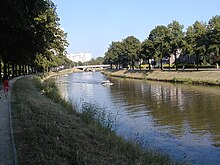Lys River
| Lys/Leie | |
|---|---|

The Leie in Ghent
|
|
| Country | Belgium, France |
| Basin features | |
| Main source |
Pas-de-Calais 115 m (377 ft) |
| River mouth |
Scheldt 51°3′18″N 3°44′3″E / 51.05500°N 3.73417°ECoordinates: 51°3′18″N 3°44′3″E / 51.05500°N 3.73417°E |
| Progression | Scheldt→ North Sea |
| Physical characteristics | |
| Length | 202 km (126 mi) |
The Leie (Dutch and German) or Lys (French) is a river in France and Belgium, and a left tributary of the Scheldt. Its source is in Pas-de-Calais, France, and it flows into the river Scheldt in Ghent, Belgium. Its total length is 202 kilometres (126 mi).
It is a very polluted river from the high population density and industrialisation in both Northern France and Belgium. Historically, the Lys valley was known for the spinning and weaving of flax. The region of the Leie (between Deinze and Ghent) was known as a favourite place for numerous painters in the first half of the 20th century.
The source of the Lys is in a village, Lisbourg, east of Fruges, in the Pas-de-Calais department of France. It flows generally northeast through the following departments of France, provinces of Belgium and towns and municipalities:
The main tributaries of the Leie are, from source to mouth: Laquette, Clarence, Lawe, Deûle and Mandel.
The river was the location of three battles between the Allies and the German Army. During the First World War in 1918 the location was the scene of the First Battle of the Lys, which was part of the German Spring Offensive and later that year of the Second Battle of the Lys, which was part of the Allies' Hundred Days Offensive. During the Second World War, the Battle of the Lys was part of the 1940 German offensive in Flanders towards the English Channel.
...
Wikipedia
